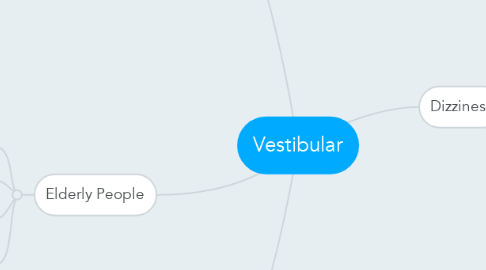
1. Elderly People
1.1. Often c/o dizziness
1.2. Fall = leading cause of accidental death in 65+
1.3. Retirement
1.3.1. Atrophy of most body systems, including vestibular
1.4. Logic:
1.4.1. You don't see old people driving super fast, riding roller coasters, etc
2. Treatment
2.1. Push to uncomfortability
2.1.1. Inform Patient
2.1.1.1. "You probably won't like this, but we need to do it!"
2.2. Watch out for concussion!
2.3. Medications
2.3.1. Typically Meclizene
2.4. Goal: Improve function, make brain adapt more efficiently
2.5. Note: Most rehab increases the function on the BAD side, but decreases function on the GOOD side === compensation
2.6. Typical pt has seen 5 other drs before you
2.7. Improve sensation
2.7.1. Foot
2.7.1.1. Monofilament
2.7.2. Dermatome
2.7.3. Remember: Diabetes = non-dermatomal pattern
2.7.3.1. Distal to Proximal
3. Pathology
3.1. Oscillopsia
3.1.1. Visual Impairment when you move your head in any direction = lose focus
3.1.2. Things OSCILLate
3.1.3. Blurred Vision
3.1.4. Have them READ something, look at a target
3.1.5. Reflex Related to it: VOR
3.1.5.1. Vestibulo Ocular Reflex
3.1.5.1.1. You move your head, your eyes move the same, but opposite so you can still focus
3.1.5.2. Other reflexes leading to balance
3.1.5.2.1. VestibuloSpinal Reflex (VSR)
3.1.5.2.2. VestibuloCochlear Reflex (VCR)
3.2. BPPV Benign Paroxymal Positional Vertigo
3.2.1. Otoconia in utricle get knocked loose and go into semicircular canal
3.2.1.1. Hair cells read the density of liquid in inner ear
3.2.1.1.1. Tells brain where your head is in space relating to:
3.2.2. 2 Types of BPPV
3.2.2.1. Canalothiasis
3.2.2.1.1. Most common
3.2.2.1.2. Otoconia Free float in canal
3.2.2.2. Cupulothiasis
3.2.2.2.1. Otoconia in cupula
3.2.3. Central Vs. Peripheral Issues
3.2.3.1. Central = brain, SC
3.2.3.2. Peripheral = inner ear, etc
4. Dizziness
4.1. Definition is very broad
4.2. Causes
4.2.1. Nutrition
4.2.2. Hydration
4.2.3. Inner Ear Occlusion
4.2.4. Medications
4.2.4.1. Diabetes
4.2.4.2. Statins
4.2.4.3. Anything affecting vasodilation/constriction
4.2.4.4. Anti-Depressants & Anti-Psychotics
4.2.4.5. Anti-Seizure
4.2.5. Orthostatic Hypotension
4.2.5.1. -20 mmHg Systolic
4.2.5.2. -10 mmHg Diastolic
4.2.5.3. Important to SLOWLY ease into program
4.2.6. Vision Issues
4.2.6.1. Proprioception & Integration
4.2.6.2. Vision-Dependent?
4.2.6.2.1. If Vision is removed and balance is lost, indicative of other issue (vestibulocochlear)
4.2.7. Poor Posture
4.2.7.1. Center Of Mass
4.2.7.2. Widened Base of support
4.2.7.3. Flexor Tone
4.2.7.4. Stay close to midline of body
4.2.7.5. Low to ground
4.2.7.6. Use of railings, countertops, etc
4.2.7.7. Hunching over
4.2.8. Somatosensory
4.2.8.1. Proprioceptors
4.2.8.1.1. GTOs in tendons/muscles
4.2.8.1.2. Hyaline Cartilage
4.2.8.2. Muscle Spindles
4.2.8.3. Mechanoreceptors (esp. in feet)
4.2.8.4. Logic: If you can't feel the ground and are standing, you can easily lose balance ====
4.2.8.4.1. Peripheral Neuro (Type 2 DM)
